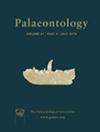Vital statistics, absolute abundance and preservation rate of Tyrannosaurus rex
IF 2.3
2区 地球科学
Q1 PALEONTOLOGY
引用次数: 0
Abstract
I present a simulation model on vital statistics, absolute abundance (N, total number of individuals that ever lived) and preservation rate (p, minimum number of fossils known divided by N) of Tyrannosaurus rex. It is based on a published age‐structured population model that assumes a reptile or bird‐like reproduction for T. rex to estimate its age‐specific survival rates. My model applies input variables and equations from a recently published model on N and p. This model yielded 2.5 billion T. rex individuals (N) and one fossil per 80 million individuals (p). The average N values calculated by my model were at minimum 27.6% and p values at maximum 361.5% that of a previous model and uncertainties in all output variables were always larger in my model. The equation on output variable ‘population density’ introduced the largest uncertainty to N and p. The output variable ‘generation time’ differed the most between models, but for N and p, the huge size of the input area modelled and geological longevity minimized this difference. Unlike my model, the generation time as well as life expectancies, gross reproduction rates, and reproductive values of individuals calculated from the previous model all strongly contradicted our current understanding of the biology of T. rex and of other theropods. Their values also disagreed with those of large extant reptiles, birds and mammals. All of these shortcomings of the previous model favour the assessment of individual and population characteristics of T. rex and of other extinct species using my model.霸王龙的生命统计、绝对丰度和保存率
我提出了一个关于雷克斯暴龙的生命统计、绝对丰度(N,曾经生活过的个体总数)和保存率(p,已知的最小化石数量除以N)的模拟模型。它基于一个已发表的年龄结构种群模型,该模型假设霸王龙的繁殖方式类似爬行动物或鸟类,以估计其特定年龄的存活率。我的模型采用了最近发表的关于N和p的模型的输入变量和方程。该模型产生了25亿只霸王龙个体(N)和每8000万个体(p)一个化石。我的模型计算的平均N值最小为27.6%,p值最大为361.5%,在我的模型中所有输出变量的不确定性总是更大。输出变量“人口密度”的方程给N和p带来了最大的不确定性。输出变量“生成时间”在模型之间的差异最大,但对于N和p,模型的巨大输入面积和地质寿命最小化了这种差异。与我的模型不同的是,从之前的模型中计算出的世代时间、预期寿命、总繁殖率和个体繁殖价值,都与我们目前对霸王龙和其他兽脚亚目恐龙生物学的理解强烈矛盾。它们的价值也与现存的大型爬行动物、鸟类和哺乳动物的价值不一致。以前模型的所有这些缺点都有利于使用我的模型来评估霸王龙和其他灭绝物种的个体和种群特征。
本文章由计算机程序翻译,如有差异,请以英文原文为准。
求助全文
约1分钟内获得全文
求助全文
来源期刊

Palaeontology
地学-古生物学
CiteScore
5.60
自引率
3.80%
发文量
43
审稿时长
6 months
期刊介绍:
Palaeontology publishes a wide variety of papers on palaeontological topics covering:
palaeozoology
palaeobotany
systematic studies
palaeoecology
micropalaeontology
palaeobiogeography
functional morphology
stratigraphy
taxonomy
taphonomy
palaeoenvironmental reconstruction
palaeoclimate analysis and biomineralization studies.
 求助内容:
求助内容: 应助结果提醒方式:
应助结果提醒方式:


